Samsung Galaxy Nexus & Ice Cream Sandwich Review
by Brian Klug & Anand Lal Shimpi on January 18, 2012 1:34 PM ESTBattery life remains the other big axis on which smartphones are judged, and here we've turned to our regular 2011 suite of battery life tests to see how the Galaxy Nexus shakes out. Our battery life testing consists of a page loading suite which loads through a few dozen pages endlessly on both WiFi and cellular data until the phone dies, with the display set at 200 nits. For the cellular tests, we're always careful to test in cellular environments with decent signal (at least -75 dBm or higher) as well, since that's a factor. Next is a simple call test where we play music at both ends of a call until the device under test dies, and our final test is a WiFi hotspot workload which consists of four page loading tabs and a 128 kbps streaming MP3 station that runs until the phone dies.
First up are the web browsing tests over cellular 3G; this means EVDO Rev.A for the CDMA/LTE version, and WCDMA T-Mobile for the GSM/UMTS device.
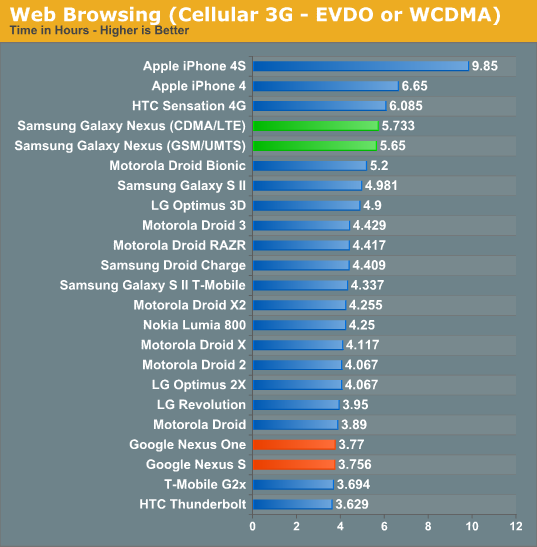
The Galaxy Nexii both do surprisingly well. I'm actually very impressed with how long the devices lasted subjectively on 3G and this definitely backs that up. Of course, both devices include beefy batteries, but Samsung has done a nice job thus far including big batteries without making devices bulky or heavy.
Next up is the same test, but on 4G LTE for the CDMA/LTE variant.
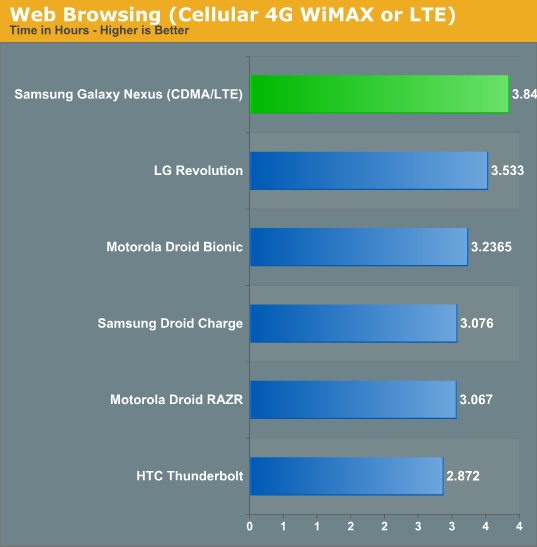
The Galaxy Nexus doesn't post numbers very far in front, but manages to come in the top of the pack on 4G LTE at just under 4 hours. This is a pretty impressive result, honestly, considering that CMC221 is likely made on the same 45nm manufacturing process as CMC220. Again, I'm impressed with the Galaxy Nexus' longevity even on 4G LTE.
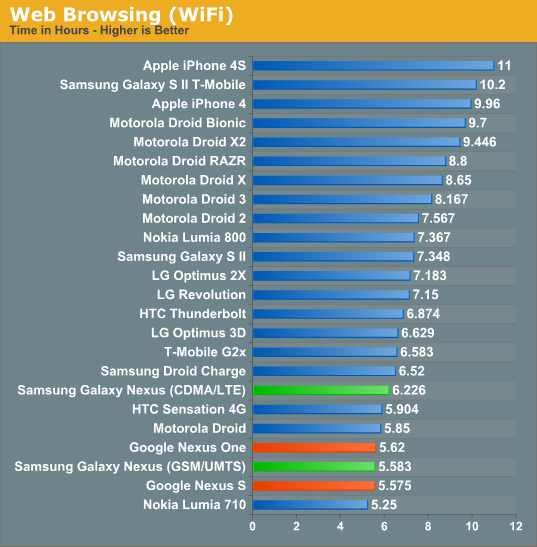
Surprisingly, the Galaxy Nexus can't break past that 6 hour mark even on WiFi, however, which does lead me to think we might be constrained by driving that display.
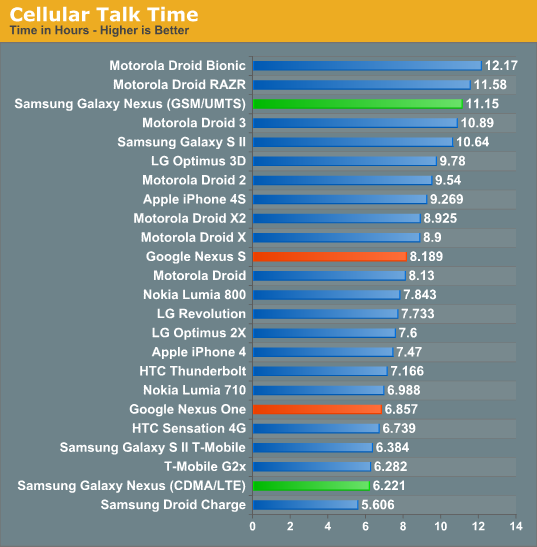
If you ever wanted to see how much difference having a different cellular architecture makes, see above. The GSM/UMTS Galaxy Nexus lasts impressively long on a voice call, at over 11 hours, yet its CDMA/LTE brother lasts just over half that.
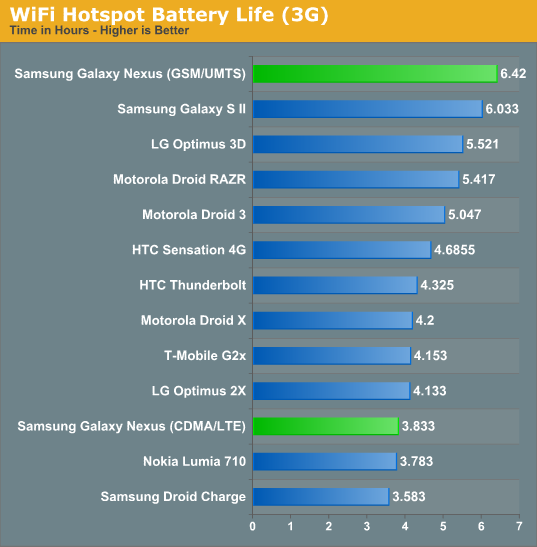
WiFi hotspot on 3G tells the same story - I'm not sure what Via Telecom's CBP7.1 draws in its active state for EVDO or 1x voice, but it seems to eat up more power than the XMM 6260 (X-Gold 626) in the GSM/UMTS Galaxy Nexus.
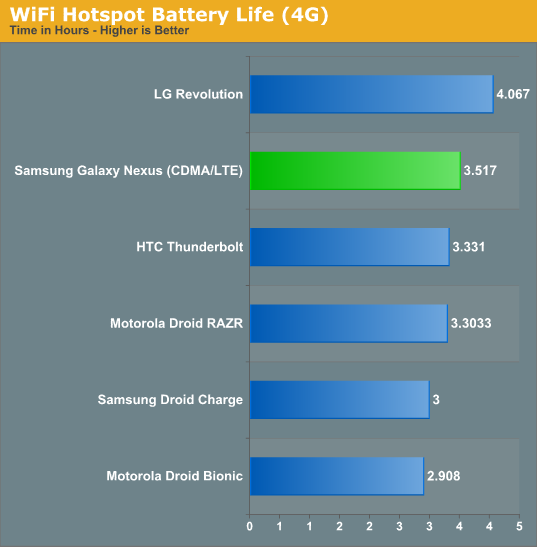
As a 4G LTE WiFi hotspot, the Galaxy Nexus loses its edge over the Revolution, but does come in just ahead of the rest of the 4G LTE herd.
The story of battery life on the Galaxy Nexus unsurprisingly depends on which variant you're talking about. For a phone with a 4.65" display, I'd say I'm impressed with the battery life on both devices - remember that the area that needs to get lit up goes as r^2 - increasing that and not killing the battery is a big feat. In addition, I'd wager that using the OpenGL ES renderpath (and accelerated browser in 4.0) definitely helped both Galaxy Nexus devices post impressive scores. As for the two variants, the GSM/UMTS device has impressively long battery life pretty much across the board. Playing with that phone, I was rarely wanting for more on my regular use schedule (I charge at night on my nightstand). We've seen XMM6260 before in numerous devices where it seems to be a pretty good citizen.
The CDMA/LTE variant, on the other hand, depends strongly on what air interface you end up using most - on 4G LTE the device comes in at the front of the pack usually, and its 3G web browsing test is above average. However, if you make a lot of voice calls, the phone might not cut it. Unsurprisingly the CDMA/LTE Galaxy Nexus does nothing to dramatically change 4G LTE battery life - for that we're still waiting for upcoming 28nm LTE basebands.










185 Comments
View All Comments
Insomniator - Wednesday, January 18, 2012 - link
I wonder if the Rezound's Adreno 220 will help with the delays using the ICS buttons.tipoo - Wednesday, January 18, 2012 - link
The chip in this one generally benchmarks right after the Mali 400, the fastest GPU in an Android phone right now. Its probably a software thing, not hardware.Insomniator - Wednesday, January 18, 2012 - link
According to anand's own benchmarks (can't find much else on the 220) the SGX540 is significantly slower...http://www.anandtech.com/show/4243/dual-core-snapd...
tipoo - Wednesday, January 18, 2012 - link
I know, but its still one of the faster GPU's out there. I don't see why the GPU would be a limitation on just the function buttons while the rest of the UI is buttery smooth.tipoo - Wednesday, January 18, 2012 - link
Also, one of the comments below ours show Android 4.03 being faster and almost eliminating that lag, so it was a software thing.doobydoo - Thursday, January 19, 2012 - link
Fair enough - it may have been a software thing.Nevertheless, it's a software thing which doesn't happen on the faster GPU of the Samsung Galaxy S2. So I'd say it's a bit of both.
zorxd - Friday, January 20, 2012 - link
Is the iPhone 4 with the slow SGX535 lagging? If not, how can it be a hardware thing?zorxd - Wednesday, January 18, 2012 - link
You are comparing a 1GHz TI OMAP4 SGX540 to a 1.5 GHz Snapdragon S3 Adreno 220.The CPU alone can explain the difference between the Optimus 3D (31 fps) and the qualcom developement platform (37-38 fps).
As you can see, single core devices using the SGX540 are even slower.
At a given CPU clock speed (let say the common 1.2 GHz) I think the SGX540 is faster than the Adreno 220.
jeremyshaw - Wednesday, January 18, 2012 - link
Different architecture. Snapdragon at 1.5GHz is probably a smidgen slower than Cortex-A9 at 1.2GHz. Remember Snapdragon as an amped-up Cortex A8.french toast - Wednesday, January 18, 2012 - link
Scorpion is not an amped up A8, they are not related in any way other than the v7 ISA.The adreno 220 is way more powerfull than a 540, the problem with it was the poor bandwidth and the terrible drivers qualcomm released it with, it you check out the scores of the samsung galaxy s2 skyrocket with those new drivers it is much faster.